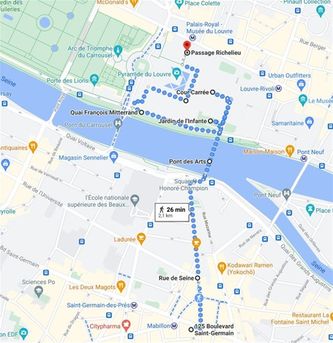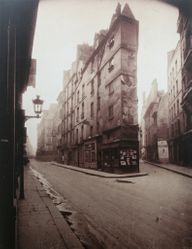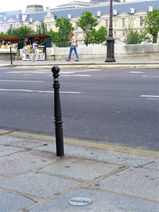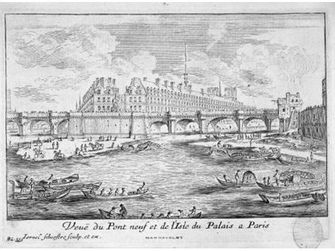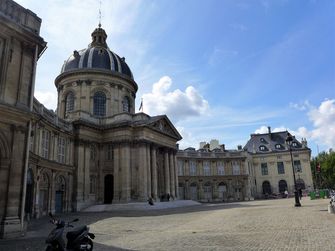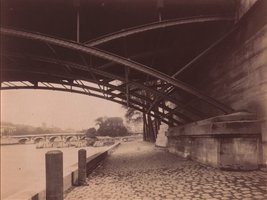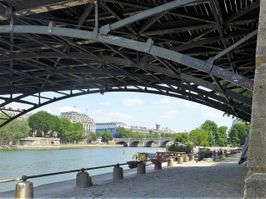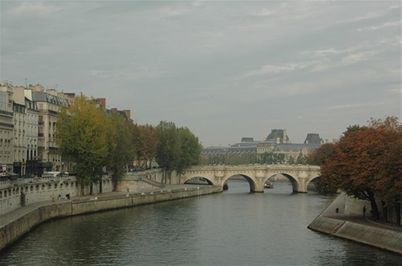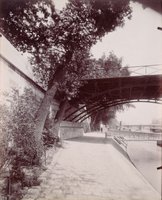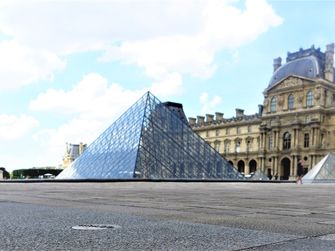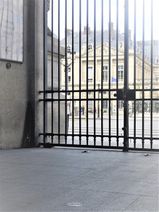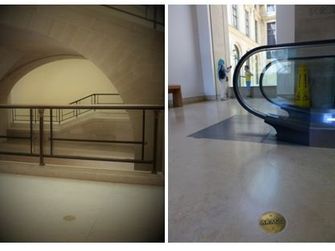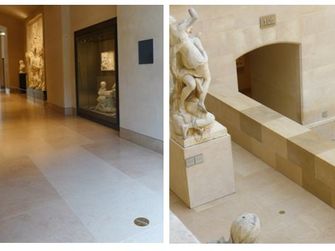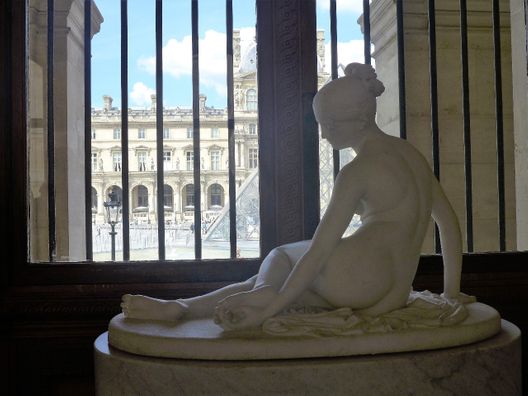Hora fugit - Un peu de Paris
Paris meridian - From Saint-Germain to the Louvre
We start from the boulevard Saint-Germain to reach the rue de Seine. Then we will continue to the Louvre by the Pont des Arts.
Rue de Seine
The stroll around the Odeon area includes also rue de Seine.
It is always a pleasure walking in this street, so attractive with its classical buildings, its many art galleries and shops. The street forms also curious intersections when it meets with the rue de l'Échaudé and the rue Mazarine. For the ones interested in the work of Atget, they will recognise the side of the building located on the intersection with rue de l'Echaudé, that he took on different times.
Corner of rue de Seine and l’Echaudé
Atget - 1911
(Musée Carnavalet)
The photograph that Atget took in 1924 is darker and more contrasted than the one he took in 1911. The early morning light casts a gloomy glow over the shiny gutters and the torn posters; the shot from a more oblique angle exaggerates the narrowness of the building giving a striking aspect of film noir to the place.
A corner - on the left, rue de Seine,
on the right, rue de l’Echaudé
Atget – 1924 - (Musée Carnavalet)
The rue de Seine runs along the imaginary line of the meridian. All the Arago medallions have disappeared; sometimes only a circular trace remains on the pavement.
At the intersection with the rue Mazarine, there is a small garden stuck in the loop that the street forms here when it joins the rue de Seine. I don't know why, when I arrive at this level of the street, I always feel a bit puzzled. The street suddenly seems to be wider, then it narrows along the wall of the Institute, only to widen again with an other little garden wedged between several buildings.
Let's take the narrow passage on the right which gives directly on the Place de l'Institut, in front of the river and the Louvre. This passage always gives me the feeling of walking through a backstage area leading to the huge stage of an open-air theatre.
The imaginary line of the meridian goes through the small passage on the rue de Seine and continues across the Place de l'Institut to the corner of the quai Conti in direction to the Louvre
Place de l'Institut
The Institut de France stands where the tower of Nesle once stood, a most infamous place per several legends.
The prints by Jacques Callot and Israël Sylvestre show two views of the place.
The one made in 1630 by Callot shows the Tower of Nesle, once an important part of the city wall constructed by Philippe Auguste in about 1200.
Behind the tower, the Hôtel de Nesle, where Henriette de Nevers would have kept in her bedroom the head of her lover Coconas, beheaded in 1574. The second print made thirty years later by Sylvestre shows the same view with the Pont-Neuf and the Place Dauphine ; the tower of Nesle is being demolished and replaced by the Collège des Quatre-Nations, which will later become the Institut de France.
Part of Cardinal Mazarin's immense fortune was bequeathed to King Louis XIV for the construction of a college. This college was to be dedicated to young nobles from provinces newly acquired from Germany (Alsace), Flandre (Artois), Italy (Pignerol), and Spain (Roussillon and Cerdagne).
The Louvre, no longer a royal residence, was housing five academies, the most famous being the Académie Française. When Napoleon decided to turn the Louvre into a museum, the academies were transferred to the former college, thus becoming the Institut de France. The chapel then was converted into a hall for the sessions of the academies. Since its foundation in 1795, the institut’s members have been wearing the famous ceremony green uniform.
Since the photo taken by Atget in 1907, very little has changed; the statue of the Republic formerly in front of the pavilion on the right is now on the Quai Malaquais up the rue de Seine; the statues of the lions formerly on the steps are now located in a garden in Boulogne Billancourt.
The Institut
Atget – 1907
(Musée Carnavalet)
Port des Saints-Pères
Let's cross the street.
Below, the port of Saints-Pères runs along the Seine river under the Pont des Arts.
Atget took a photograph from this spot showing a view of the Pont-Neuf and the Pointe du Vert-Galant. Looking more closely at the photograph, you will notice the barrage écluse de la Monnaie (the lock and dam at the Mint), between the Ile de la Cité and the left bank. Built in 1853, it allowed barges going upstream in this small arm of the Seine where numerous eddies caused considerable annoyance to boats. Becoming useless with the motorisation of barges, it was destroyed in 1924.
Port des Saints-Pères
Atget – 1910/1911
(BnF)
Pont des Arts
Let's now take the Pont des Arts, completely rebuilt in 1982-1984, after being hit by a barge in 1979.
Perfectly in line with the Cour Carrée of the Louvre and the Institut, it offers one of the most beautiful views of Paris. In one turn, you can see the Louvre, the Pont-Neuf, the Ile de la Cité, the towers of Notre-Dame, the Monnaie, the Institut and its golden dome, the Musée d'Orsay, the Eiffel Tower ... all these monuments that mark out this other stroll along the Seine.
Rest your elbows on the parapet, let your eyes wander over the water and the barges, the poplar-lined banks, the bridges and the monuments of that same stone extracted from the subsoil of Paris, enjoy the tender light falling on this open-air museum.
Port du louvre
Let's continue our walk ... we arrive on the right bank. Below the bridge, the walkway of the port du Louvre. runs along the river.
« And then there came the Pont des Arts, standing back, high above the water on its iron girders, like black lace-work, and animated by a ceaseless procession of foot-passengers, who looked like ants careering over the narrow line of the horizontal plane. Below, the Seine flowed away to the far distance; you saw the old arches of the Pont-Neuf, browny with stone-rust; on the left, as far as the Isle of St. Louis, came a mirror-like gap; and the other arm of the river curved sharply, the lock gates of the Mint shutting out the view with a bar of foam. »
(His Masterpiece – Emile Zola).
Port du Louvre,
below the pont des Arts
Toward the Pont-Neuf
Atget – 1910
(Musée Carnavalet)
Louvre - Cour Carrée
We are now going to walk along the Louvre, which had been the castle of the kings of France before becoming the most visited museum in the world.
Before, let's take the time to enter in the Cour Carrée (the Square Courtyard), where the dungeon of the old medieval Louvre once stood. The lower part of the dongeon can be seen today in the museum's basement.
The walls of the medieval Louvre were progressively demolished in favour of a Renaissance palace. One Renaissance facade has remained with the Lescot wing, on the left of the prominent pavilion (Pavillon de l'Horloge – Clock Pavilion). This pavilion was built later by king Louis XIII. The other north and east wings were rebuilt by king Louis XIV.
We can recognise the various kings by their monograms engraved in the stone:
- H for Henri II and the intertwined H and C for Henri II and the queen Catherine de Medici. (I am always tempted to read the letter D instead of the letter C).
- K for Charles IX
- L for louis XIII with the letter A for the queen Anne of Austria
- L also for Louis XIV but topped by the letters LB meaning Louis de Bourbon.
Let’s now leave the Cour Carrée to walk along the Jardin de l'Infante (the Gardens of the Infanta). The name has been kept from the short stay in the Louvre of the young Spanish Infanta promised to her cousin Louis XV. The Infanta, only age three, lived in apartments overlooking this small garden before moving to the court of Versailles. She stayed there for four years before finally returning to Spain...
Louvre - Waterside Gallery
After the garden, there is a small pavilion with a balcony. According to a story contested by historians, the king Charles IX shot to protestant people from this balcony during the Saint Bartholomew's Day massacres. Though it has been proven that the balcony did not exist at that time, Charles IX's responsibility for the events of St. Bartholomew's Day cannot be denied. They started here in the Louvre with the murders of the protestant leaders gathered for the wedding of Queen Margot and the future Henry IV. Around three thousand Protestants were murdered in Paris between 24 and 28 August 1572.
Louvre
"Charles IX balcony"
Atget - 1913
(MoMA)
Let's continue along the Louvre up to the Carrousel gates.
Instead of an expected Arago medallion on quai François Mitterrand in front of the pavilion Daru, I found a very curious dolphin-shaped gutter descent...
Louvre - Cour Napoléon - Pyramid
Let's enter into the Cour Napoléon.
As the very symbol of today's Louvre, the elegant glass pyramid designed in 1989 by the Sino-American architect Peï, was widely contested at the beginning. Far from being incongruous, it brings delicacy and harmony to the imposing Napoleon courtyard framed by seven monumental pavilions.
Already in 1984, Peï used pyramid-shaped structure for the IBM headquarters in Somers, one of the most impressive locations I have ever seen in my professional career.
The Louvre pyramid is positioned along the Historical axis which runs from the Cour Carrée of the Louvre, the Arc de Triomphe du Carrousel, the Tuileries Palace destroyed in 1871 during the Paris Commune, the Place de la Concorde, the avenue des Champs Elysées, the Arc de Triomphe de l'Etoile up to the Grande Arche de la Défense.
The Meridian line passing through the corner of the Daru pavilion towards the Richelieu passage tangents also the pyramid.
The replica of Bernini's statue of the Sun King chosen by the architect Pei placed in front of the Pyramid reinforces the historical and solar symbolism of the place.
The president François Miterrand, named the Sphinx, who was a lover of history, esotericism and Ancient Egypt obviously left his mark here combining politics, history and spirituality.
Louvre - Passage Richelieu
I was lucky enough to discover the Louvre when I was a child, through short visits, especially on winter Sundays. It was an ideal way to discover this vast and rich museum in small steps. With my mother, we were wandering through the immense rooms, sometimes getting lost, but each time it was a beautiful encounter with a painting, a sculpture, a sarcophagus ... One might also wonder whether my great interest in the Louvre and its Egyptian antiquities was not amplified by Belphégor, a 1965 French cult TV show…
Let's cross the Cour Napoleon and enter the Passage Richelieu. An Arago medallion can be seen at the end of the passage behind the gate on rue de Rivoli.
Louvre - Museum
Let's now enter the Louvre. You may find some Arago medallions on level 0 of the wings Richelieu and Denon. I hae found 4.
Enjoy the visit in this beautiful museum where you will find also many masterpieces!
Texte / Photos : Martine Combes
Contact / newsletter:
